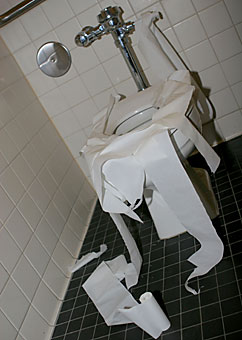 |
|
Photo Illustrations by Claire C. Laurence/Arizona Daily Wildcat
|
The UA does not currently use toilet seat covers in campus restrooms because of the estimated $10,000 per year that it would cost to stock them. Union officials are beginning a 'trial run' in certain facilities in order to determine if the seat covers are a necessary commodity.
|
|
|
By Danielle Rideau
Arizona Daily Wildcat
Monday, December 5, 2005
Print this
The "double cover and hover" is a popular maneuver for people who are afraid of dirty toilet seats in public restrooms. While the hover maneuver might be possible in UA lavatories, the "double cover" isn't because most stalls don't have the paper butt-protectors.
Toilet seat covers are sheets of paper men and women can use instead of hovering to protect their backsides from germs on the seats of public restrooms. These fixtures are noticeably absent from UA restrooms, and Dave Parker, associate director of operations in the Arizona Student Unions, said they haven't been provided in the past because of the yearly cost.
Parker said it would cost $5,000 to $10,000 annually to supply both the Student Union Memorial Center and Park Student Union with toilet seat covers.
That answer isn't good enough for some students, who said cleanliness should come before costliness.
"I want to have the option of a seat cover to make me feel better about using the bathroom," said Brittany Price, a political science junior.
Rebecca Ascher, a pre-pharmacy junior, said she thinks it doesn't make sense not to have toilet seat covers.
"There are so many people using the bathroom, they might be a lot cleaner if they had (toilet seat covers)," Ascher said.
To suppress the cries of women who need to double cover, Parker said he will be installing two toilet seat cover dispensers in the west bathroom of the student union to test if there really is a demand in the women's bathrooms.
"We are exploring all aspects of using (toilet seat covers), and if they work we will keep them," Parker said.
The three new dispensers will bring the number of union restroom stalls that provide the sanitary liners up to four because seat covers were installed in a restroom outside of the Associated Students of University of Arizona's office when the student union was under construction in 2000.
If it's determined that seat covers are being used, Parker said he will make room in the union budget to provide the seat covers and dispensers in all of the bathrooms.
"You're the customer, we will do what we have to, to accommodate you," Parker said.
But that doesn't mean your behind will be accommodated in every academic setting.
Facilities Management, which is responsible for cleaning restrooms on campus excluding the unions, does not put seat covers in any restroom in any building.
While it would cost up to $10,000 to put seat covers in the unions, it would cost upward of $40,000 to make sure they are in every building, said Chris Kopach, Facilities Management associate director.
Kopach said there are some buildings that do provide covers, but it's paid for out of their own budgets and not Facilities Management dollars.
The facilities that do provide their own seat covers include the "Swede" Johnson building and Parking and Transportation Services, Kopach said.
While most of the campus restrooms do not provide the seat protection that students like Ascher desire, both Parker and Kopach said their custodial staffs have cleaning standards that keep the restrooms clean enough, making the extra protection unnecessary.
Parker's custodial staff is expected to clean every bathroom at least once every two hours, and they "disinfect toilets and urinals, remove the trash, sweep and restock toilet paper," he said.
If toilet seat covers are installed, the cleaning regimen shouldn't become more of a burden, Parker said, because the staff will still sanitize each restroom.
Their job might become a little easier, though, because they won't have to restock toilet paper as frequently because patrons won't be using it to line the toilet seats, Parker said.
All of the clamor about protecting your buttocks from germs that lurk on public toilet seats might be psychological though, because tests have shown the toilet seat is actually the cleanest area of the bathroom.
An ABC News "20/20" report tested what many people believe to be the dirtiest places in the bathroom: the toilet seat, the floor and the sink fixtures.
Their study showed the restroom floor to be the dirtiest with 200 times more bacteria than a sanitary surface. The toilet seat, however, ended up being "the cleanest spot" of the bathroom.
But even considering these facts, people still continue to hover or line the seats with strips of toilet paper.
"I don't care if the toilet seat is the cleanest spot, I don't want to sit on the same seat that everyone else's butt has touched," Price said.
